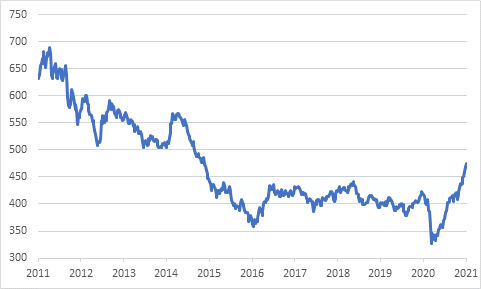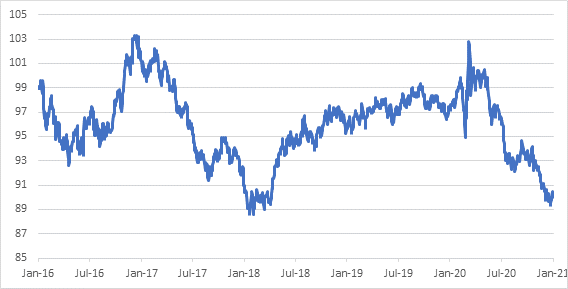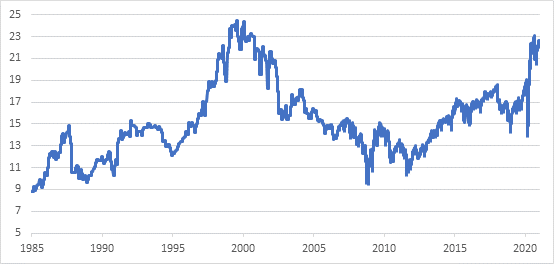Izak Odendaal and Dave Mohr, Investment Strategists at Old Mutual Wealth
Did 2020 ever end? It doesn’t feel like it. In the first few days of 2021 we’ve seen Covid-19 infections rising unabated, lockdowns, load-shedding, political chaos in the US and wild Bitcoin swings.

Old mutual
Importantly though, we’ve also seen the hope that better days lie ahead. Millions have already been vaccinated against the coronavirus in the past few weeks, mainly
in developed countries at this stage. Although this is still only a drop in the ocean, it’s a solid start that puts several countries on the road to herd immunity.

old mutual
Traditionally this is the time of year when the big themes for the coming 12 months are presented from the point of view of South African investors. This year, humility demands that we pose five questions instead of making predictions. Our job is not to forecast but to build portfolios that can withstand a range of outcomes.
QUO VADIS COVID?
The first question is on the coronavirus itself. Several countries have re-imposed strict lockdowns in response to alarming increases in Covid-19 cases and hospitalisations. The UK, in particular, has reeled from a new variant of the coronavirus, as has South Africa. But while Britain went into a third lockdown just before Christmas, most South Africans have got off lightly. Curfews, beach closures and alcohol bans are an inconvenience, but not debilitating unless it’s your main source of income.
Only successful mass vaccinations will assure that lockdowns will become a thing of the past. Although we cannot afford to mess this up, South Africa’s vaccination
strategy has underwhelmed, to say the least, but fortunately, we do benefit indirectly from other countries’ vaccine roll-outs.
From a medical point of view, the second wave has been every bit as bad or even worse than the first in most countries. However, the economic impact has been much milder. This is partially due to the less restrictive lockdowns (particularly in the US) and the fact that the shock factor has waned and people have adapted to new ways of working. It also helps that China, the world’s number two economy, has not experienced a second wave and is enjoying very strong economic growth. It posted 6.5% year-on-year growth in the fourth quarter, becoming the only major economy to surpass pre pandemic levels of economic activity.

The latter is one of the main reasons 2020’s commodity price gains have continued into 2021. The decade long commodity bear market also meant that mining companies were circumspect about bringing new supply on stream, which supports prices. It also means that investors view it as an asset class with upside potential. It is hard to overstate the importance of higher dollar commodity prices for the local economy, the fiscus, the rand and the stock market. The FTSE/JSE All Share Index hit a new record high last week, while the rand has recouped most of its early 2020 losses. Among major commodities, oil is the laggard, but that suits us as an importer.
POLICY AND POLITICS IN THE US
The second question is on policy, particularly US policy, since US markets set the tone for the rest of the world. Just before Christmas, the US Congress passed a $900 billion spending bill that included extended unemployment benefits, support for small businesses and one-off $600 direct payments to many Americans.
The political situation subsequently took a dramatic turn, and most of the media focus has understandably been on the incredible scenes of rioters storming the Capitol building, egged on by their own president as he continued to refuse to accept defeat in the November election. For inciting this insurrection, Trump was impeached last week in the House of Representatives for the second time. A Senate trial now awaits, but only after Wednesday’s inauguration of Joe Biden.
From an economic policy and therefore investment point of view, the more significant development was that Democrats won both run-off elections in the state
of Georgia, giving them effective control in the Senate. There are now 50 Senators from each party, with the vice president casting the deciding vote in the case of
deadlocks.
This increases incoming President Biden’s ability to execute his domestic agenda since Congress (comprised of the House and Senate) controls the purse-strings. He duly announced his plans for another $1.9 trillion spending package that will expand on the earlier one and also include support for state and local governments that would otherwise be forced to lay off more workers, including teachers and police, and cut spending to balance the books. Already more than a million government employees have lost their jobs due to the pandemic.
With slim majorities in both the House and the Senate, these proposals are subject to change and will possibly be watered down, but it does suggest that fiscal policy will be accommodative in the world’s largest economy in 2021. One negative from the point of view of shareholders is that the 2017 corporate tax cuts could be rolled back, at least in part. We also know that monetary policy will remain supportive since the Federal Reserve has explicitly said so after its December meeting. Chair Jerome Powell re-emphasised this point last week in an online discussion. The same goes for the world’s other major central banks. Our own Reserve Bank’s Monetary Policy Committee will meet this week and we will discuss the domestic inflation and interest rate outlook next week.

DOLLAR DIRECTION
The third and related question is on the trajectory of the US dollar. The consensus view is that the dollar will continue weakening this year (it fell to a three-year low at the end of 2020), but the consensus can be wrong. On the one hand, the large scale fiscal and monetary stimulus in the US relative to other major countries does point to a weaker currency. On the other hand, if more stimulus leads to faster growth (and upward pressure on interest rates), the dollar could benefit. Either way, the euro, yen, yuan and pound all have their own shortcomings, so in a sense, it is a matter of finding the cleanest dirty shirt.
For the time being, however, a softer dollar is good news for many. The world runs on dollars and if the dollar is too strong, it can be like grit in the wheels of global
commerce. The world also largely borrows in dollars, and a stronger dollar increases the debt burden for those borrowers, particularly those in emerging markets. Finally, a strong dollar is usually a sign of investor risk aversion, so a softer dollar tells you investors are feeling more confident.
BUBBLE-SPOTTING
The fourth question is also a tricky one: is there a bubble in stocks, particularly US technology shares? The S&P 500 Equity Index is trading at 22 times 12 month forward earnings, led by the giant technology platform shares. The last time it was this expensive was in 2000 as the dotcom bubble was deflating.
They say the most dangerous phrase in finance is “this time is different”, but there are three main differences from that 1990s bubble. Firstly, interest rates are at record lows. At the turn of the millennium, the 10-year Treasury yield was 6.6%, compared to less than 1% currently. As interest rates fall, the present value of future profits rises, making firms with good earnings prospects like the tech companies more valuable. Bubbles always have a psychological dimension and depend on irrational optimism and narratives about a paradigm shift. This might be present in some corners of the investment universe such as Bitcoin. But to the extent that stock valuations are underpinned by low interest rates, it reflects a fundamentally pessimistic view. After all, interest rates are not rock bottom because everything is hunky-dory.
It also suggests that rising bond yields could be the biggest threat to the valuations of the high-flying growth shares. However, rising bond yields would most likely
occur with a stronger economy, which would be a boost to other companies whose shares have lagged in the K-shaped recovery. Since the first vaccine news broke
back in November, giving hope for a stronger economy, we have seen signs of the cheaper value shares and small caps improving relative to the more expensive growth shares.
Secondly, we are at the start of a new economic cycle, not the end. That means some companies can conceivably grow into their valuations. Thirdly, the big tech companies are already profitable, unlike the dotcom bubble when all manner of loss-making firms were being hyped (though there are plenty smaller listed companies who are not profitable yet, but have seen their share prices rally).

Tesla is exhibit number one for those who cry bubble, but it is at least (finally) profitable. It had to show four consecutive quarters of profit to qualify for S&P 500 inclusion. In fact, Tesla’s explosive share price (which has made founder Elon Musk the richest person on earth) tells us something about the market, as James Mackintosh pointed out in the Wall Street Journal.
You would expect the share prices of other car makers to fall proportionally to Tesla’s rise as Tesla will presumably take market share from them. But they haven’t, suggesting that we are dealing with two very different groups of investors. The one group is made up of traditional investors who look at a shares’ fundamental prospects, while the other group sees investing as a form of entertainment.
Either way, the outperformance of tech stocks cannot last forever, even if the underlying technologies (like electric vehicles) continue to gain traction. Big tech is already 25% of the S&P 500. If it continues outperforming forever, it will
eventually become 100% of the benchmark. Valuations give no indication of when trends reverse, so investors always need to weigh the potential downside
of investments that appear expensive with the potential upside that remains. Unable to predict the future, we prefer diversification as the approach to this question, including diversification across investment styles.
TURNING THE CORNER
This leads us to the fifth question. Is this the year when things finally get better? The past number of years each saw weaker-than-expected economic growth even after economists lowered their forecasts. In turn, this meant that tax revenues disappointed and the government’s budget deficit widened instead of narrowing as promised. Covid-19 completely blew up the deficit, making the road to fiscal consolidation more urgent but also more difficult.
2021 should see pretty decent real growth of 3% to 4%, but this is largely just the snap-back from 2020’s big contraction. Only towards the end of the year will we
know whether there is renewed underlying vigour in the economy. The global economic recovery should certainly help.
Domestic reforms might also start having a positive impact, though implementation seemingly always proceeds at a snail’s pace. The most important challenge remains a reliable electricity supply, but there are plenty of other stones the government should roll out of the way to make it easier for businesses to expand and grow.
Stronger economic growth is the best way to deal with the government’s debt burden. But until it arrives, spending discipline will be key. The government won its December court case against public sector unions over the 2020 wage freeze. While unions have appealed, it does suggest that government is serious about capping the wage bill and has a reasonable chance of success in doing so.
Unfortunately, neither the appeal nor the salary negotiations for the next three years will be concluded by the time of the February Budget Speech. Investors will
have to wait a bit longer for clarity, but progress seems likely.
The road to recovery both abroad and at home is not going to be a straight line nor will it be smooth. There will be bumps in the road, both financially and economically, and unexpected twists and turns. For the time being, however, there is reason to be optimistic.
While it doesn’t feel like 2020 is quite over, it is ending

